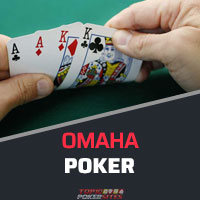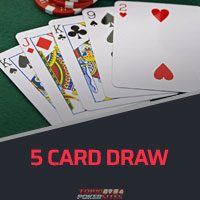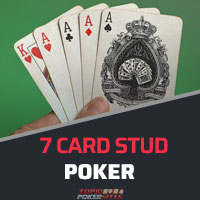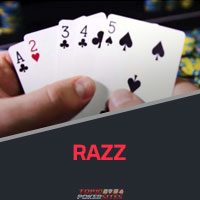Rules of Poker - Essential Guide to Basic Poker Rules
Learn the essential rules of poker in my guide that covers all the details surrounding the deck, hand rankings, betting, raising, table limits, variations, and more.

While poker might be one of the most complex gambling games, its rules are still relatively clear and simple.
The goal of poker is to create the best possible hand combination using a particular hand ranking system. Poker is also a rare game where you can bluff your way to victory without having the best hand, which gives it a high skill factor.
Following are some basic poker rules you should learn before taking a seat at your first poker table, whether online or in person.
 Poker Variations and Their Basic Rules
Poker Variations and Their Basic Rules
Naturally, poker rules differ between variations, so we’ve created individual sections where you can learn more about each:
Texas Hold’em

Texas Hold’em is by far the most popular form of poker today, and many players agree that it’s the most interesting one.
A game of Texas Hold’em includes 2 to 10 players and a 52-card deck. The betting limits can vary, but each round is played in the same way.
Here is a step-by-step guide on how to play Texas Hold’em:
- One player acts as the dealer. Even if you’re playing in an official casino where a professional dealer deals the cards, there’s still a dealer button placed in front of one of the players that indicates who will act first. The player on the button changes after each round in a clockwise direction.
- Each player must put down a nominal bet to get the action going. This bet is called the ante.
- Players on the left of the dealer button are called the small blind and the big blind, respectively. The small blind puts double the amount of ante in the pot, while the big bling puts twice as much as the small blind.
- Every player receives two face-down cards (also referred to as hole cards).
- The first betting round (pre-flop) begins, and players perform an action according to the cards they were dealt. The first player to act is the one seated left of the big blind (under the gun).
- Players make their moves in a clockwise direction and can choose to fold (surrender), call (match the current bet), or raise (bet more than the current highest bet).
- After all the players have agreed upon the same bet, three face-up cards will be placed in the middle of the table (the flop). These cards are known as community cards, and every remaining player can use them in combination with their hole cards to make up a hand.
- Another betting round begins. The players can now choose to bet, check (if there were no bets made behind them), call, or raise. After the round of betting is over, the fourth community card will be revealed (the turn).
- Another betting round starts and follows the exact same rules as the previous ones. If there are still two or more players left standing, the dealer will flip the fifth and final community card (the river).
- After the river, the final betting round commences. If there are more than two players who haven’t folded until this moment, it’s time for the showdown.
- At the showdown, all remaining players must show their hands. The winner is a player with the best five-card combination.
The winner is decided by specific Texas Hold’em poker rules and hand rankings. Here are all hand rankings in Texas Hold’em from weakest to strongest.
- High Card — An unpaired card with the highest value in a five-card combination e.g. 5 , 6 , J , Q and A
- Pair — Two cards of the same value e.g. A and A
- Two Pair — Two sets of two cards with the same value e.g. A , A , K and K
- Three of a Kind — Three cards of the same value e.g. 2 , 2 and 2
- Straight — Five cards in concession (e.g. 5 , 6 , 7 , 8 and 9 ). An Ace can count as a high card (after King) or as a low card (before 2).
- Flush — Five cards of the same suit e.g. A , J , 9 , 6 and 3
- Full House — Three of a kind plus one pair e.g. Q , Q , Q + J and J
- Four of a Kind — Four cards of the same value e.g. A , A , A and A
- Straight Flush — Any five consecutive cards of the same suit e.g. 5 , 6 , 7 , 8 and 9
- Royal Flush — A same-suited straight from 10 to Ace e.g. 10 , J , Q , K and A
The hand rankings, blind positioning, and betting rules in Texas Hold’em work the same for most other poker variants, so use this information to fully understand other forms of poker.
Omaha Poker

At the start of each round, the dealer will give four hole cards instead of two to each player. The button, blinds, antes, betting rotation, and community board work just the same as in Texas Hold’em.
However, things get a little different when it comes time to decide a winning hand.
Namely, players are only allowed to use exactly two cards from their hand and exactly three cards from the board.
This means that calculating the best hand is a little bit more complicated, and that’s why many beginner players prefer Texas Hold’em to Omaha because of its simpler rules.
In the game of Hi-Lo, which is a sub-version of Omaha poker, flushes and straights don’t count, and two players can win the pot — a player with the lowest hand and a player with the highest hand.
5-Card Draw Poker

In this version of the game, each of the players receives five cards from the dealer. There are no community cards, and the best five-card hand wins at the showdown.
After the blinds and the antes have been put into a collective pot, the dealer gives five cards to all players. According to the cards they’ve been dealt, players start the first round of betting.
Once the betting round is completed, the draw can begin.
Each player is allowed to discard any number of their cards and draw new ones from the deck. Of course, a player can discard or keep all five of their cards during the draw.
Once the new cards have been dealt and each player again has five cards in their hands, the second and final betting round can begin. If two or more players are left standing, they all must show their cards, and the best five-card hand wins the pot.
7-Card Stud Poker

Before the cards are dealt, all players must chip in with an ante. There are no blinds in 7-Card Stud.
The dealer then gives each player three cards, two being face-down and one face-up.
Unlike Texas Hold’em where the dealer button determines the betting order, the betting in 7-Card Stud starts with the player who has the lowest up-card (the door card).
7-Card Stud is a limit game, meaning that the limits of the bets are predetermined. Apart from the ante, there is a small bet and a big bet.
The first player to act can bet the “bring-in” (bet an equal amount of the ante), or “complete” by putting in an amount equal to the small bet. Players who decide to raise can only put in a small bet to raise the bring-in, or make a big bet to raise a small bet.
After the first betting round (third street) is completed, the dealer will give each of the remaining players the fourth card face-up. The second betting round (fourth street) starts with a player who has the best two up-card combination and continues clockwise.
The same rules apply for fifth and sixth streets, only the betting limits are not doubled. The final seventh card is dealt face down to each player. Once it’s completed, players can turn over their down-cards and the best five-card poker hand wins the pot.
Razz Poker

Hand rankings in Razz poker take some time to get used to, but they are basically like in regular 7-Card-Stud poker, only the objective of the game is to “lose” and have the “worst” possible hand.
In a version of the game called London Lowball, straights and flushes do count against a player’s hand, so the best possible hand is 6 , 4 , 3 , 2 and A .
Poker usually requires more than one player, but some online versions of the game allow you to play alone, either with RNG-based poker machines or by going against the dealer.
Video Poker (Jacks or Better)

The game is also called Jacks or Better because you can’t win with a high card or if you have a pair that’s lower than jacks.
If you get a pair of jacks, queens, or kings, you can only break even, while better hand combinations bring you a profit.
Here is an easy-to-follow chart on how Jacks or Better video poker usually pays out.
| Coins | 1 | 2 | 3 | 4 | 5 |
|---|---|---|---|---|---|
| Royal Flush | 250 | 500 | 750 | 1000 | 4000 |
| Straight Flush | 50 | 100 | 150 | 200 | 250 |
| Four of a Kind | 25 | 50 | 75 | 100 | 125 |
| Full House | 9 | 18 | 27 | 36 | 45 |
| Flush | 6 | 12 | 18 | 24 | 30 |
| Straight | 4 | 8 | 12 | 16 | 20 |
| Three of a Kind | 3 | 6 | 9 | 12 | 15 |
| Two Pairs | 2 | 4 | 6 | 8 | 10 |
| Jacks or Better | 1 | 2 | 3 | 4 | 5 |
Casino Hold’em

Before the cards are dealt, you are able to decide on how high your ante is going to be. Once the two cards are shown to you and the flop has been put on the table, you can decide to either fold or call by doubling your initial bet.
There are no more bets after this and the dealer will reveal the last two community cards, as well as their own cards. The best five-card hand wins.
The payouts in Casino Hold’em can vary depending on the version you’re playing. If the dealer qualifies with a pair of fours or better, you will get an extra payout for the win.
 Additional Poker Rule Resources
Additional Poker Rule Resources
If you want to take your poker rule knowledge to the next level, we have a great range of guides on more advanced topics below:
 Poker Deck
Poker Deck
Most popular poker variations are played with a standard 52-card deck with no jokers. In live poker, the decks change relatively often, with the seal wrapping being taken off in full view of the players.
 Poker Hand Rankings
Poker Hand Rankings
One of the things most beginners struggle with is learning which hand of cards wins. So, before you even consider sitting at a poker table, you should get the hang of the basic poker hand rankings.
Between straights and flushes, it can get a little tricky. For that reason, I suggest that you study the rankings guide below, and then move on to the next chapter of this poker lecture.
It’s actually not all that difficult, especially if you played other card games. Here’s it how it goes, from the strongest to the weakest:
- Royal Flush — A straight from a ten to an ace, all of the same suit e.g. 10 , J , Q , K and A . In poker, all suits are worth the same.
- Straight Flush — Any straight that has all five cards of the same suit e.g. 5 ,6 , 7 , 8 and 9 .
- 4 of a Kind — Four cards of one rank + any other unmatched card e.g. A , A , A and A + 9 .
- Full House — Three matching cards of one rank + two matching cards of another rank e.g. Q , Q , Q + J and J
- Flush — Five cards that are of the same suit, but not in sequential rank e.g. A , J , 9 , 6 and 3
- Straight — Any five consecutive cards that are not of the same suit e.g. 5 , 6 , 7 , 8 and 9
- 3 of a Kind — Any three cards of the same rank. The remaining two cards are not of this rank nor are they the same with each other e.g. 2 , 2 and 2
- 2 Pair — Any two cards of the same denomination + two cards of another denomination e.g. A and A + K and K
- 1 Pair — Any two cards of one rank e.g. A and A
- High Card — Five cards that don’t fall into any of the categories above e.g. 5 , 6 , J , Q and A
At first glance, this might seem confusing, so take your time to absorb this information. In poker, no one will be rushing, and you take all the time you want. Better safe than sorry, right?
You know how the old saying goes — repetition is the mother of learning. This saying can be applied to poker as well. After a couple of rounds, it will all come together. And even if you make a mistake, don’t beat yourself about it. Nobody is born with an innate knowledge of poker. If you’re a sore loser, this article may prove useful.
 Buy-Ins and Betting
Buy-Ins and Betting

The buy-ins are usually at least 10x for limit poker and 40x for pot limit and no limit.
Before the cards are dealt, players need to put up a small sum called the ante, while the last two players to act are the small and big blind, and they need to put in a little more.
Once the cards are dealt, the players bet and raise according to the rules and limits.
The position of a player to act first (under the gun) changes each round, and so do small and big blinds, which act last.
The round finishes in one of two ways:
- A player with the best hand wins at the showdown.
- Everyone folds but one player.
 Understanding Table Limits
Understanding Table Limits
There are three different types of poker table limits:
- Fixed limit — No one can bet more than the predetermined amount.
- Pot limit — Bets and raises are limited to the current size of the pot.
- No limit — There are no restrictions on how much you can bet or raise.
 Where to Play the Best Poker Games Online?
Where to Play the Best Poker Games Online?
If you feel like you’ve mastered the rules of every poker variant, you should test your skills online where you will find plenty of poker action.
The list below includes some of the best poker sites in 2020. They are all completely legitimate, have great bonuses for new players, and feature state-of-the-art software that will guarantee you the best poker experience.
My list of the best poker sites which I consider to be the best rooms to play in 2024:- 100% Legal & Licensed
- Verified Bonus
- Mobile Friendly
- Advertiser Disclosure
Kindly be aware that some links on Top 10 Poker Sites are affiliate links, for which we may earn a commission. Find out more on our terms & conditions
- Must be 18+ to participate.
Displayed 3 of 8 rooms
 Conclusion
Conclusion
Each poker variation has its charm. No matter what form of poker you end up choosing, you should know that you can read all about its rules in detail right here on this site.
I hope that my guide was helpful to you and that you learned something new about poker.
If you have any additional questions about poker rules or you feel like you want to add something, just leave a comment below and I will be more than glad to reply.
Good luck!
 FAQs
FAQs
What is a buy-in?
A buy-in is the amount players need to bring to the table if they want to play. The minimum buy-in is always determined, whereas the maximum buy-in may remain open.
What are big and small blinds?
The big blind and the small blind are the initial bets placed by the two players to the left of the dealer before the cards have been dealt. These bets are made to make the round worth playing for other players.
What is the main objective in poker?
The main objective in poker is to win the pot. You can win the pot either by having the strongest hand at the showdown or by making all the other players fold by playing aggressively.
Do I need to know poker terms in order to play?
Yes, you absolutely must know all the most important poker terms before playing your first poker game. You will have a hard time following the game and winning if you do not know the basic glossary.



